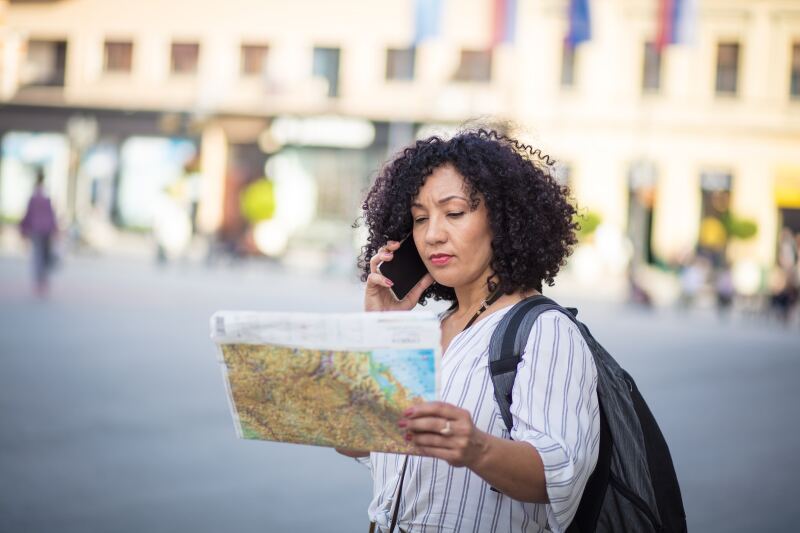Let’s be real: Just because you’re traveling doesn’t mean you’re going to ditch your cell phone. And that’s OK! Your handset should be an integral part of any trip you take. They snap gorgeous photos, and with an ever-growing number of travel-centric apps and features (Siri, how do I ask “where’s the bathroom” in Farsi?), phones help keep us connected.
Still, vacationing can be hazardous for your phone: pickpockets, roaming charges, and unexpected drops. And figuring out the ins and outs of international calling, like whether or not high-speed data is worth it, and the fine print behind unlimited data can be quite the task.
That’s why we’ve put together this practical guide for prepping your cell phone for travel, no matter if you’re heading to Nashville to visit your sister, attending your best friend’s wedding in France, or heading to Phnom Penh in search of the top Khmer food.
Here’s everything you need to know about traveling abroad with a cell phone:

Many cell phone carriers offer international roaming data options—for a price.
Courtesy of Unsplash/Getty Images
How to prep your phone for international travel
First things first: Before you set foot on international soil (even if it’s a quick USA to Canada getaway), call your cell phone carrier or peruse the specifics on its website to find out exactly what your plan charges for international travel. Trust us, it pays to be wary when you’re looking to maintain your phone’s status as your go-to hot spot for communication and all things digital. Cell phone companies have no issue gouging customers with extreme international roaming fees that result in bills of $5,000 and higher
That being said, many providers offer special international roaming agreements and international phone plans that you can add to your regular plan for the duration of your trip. Varying from carrier to carrier, these packages typically give you a certain amount of voice minutes, text messages, and data to use while overseas—some even offer unlimited calling. AT&T, for example, has an International Day Pass instead of an international monthly plan; it spans more than 210 destinations for $10 a day. This option offers unlimited talk, unlimited texting, and high-speed data, and plan owners are only charged for the days that the phone is used. One super-helpful add-on is the ability to extend the unlimited plan to an extra phone number for only $5 a day. But what makes this one of the best international cell phone plans is that you will only be charged for 10 days (total) per line in a single billing cycle.
Verizon also offers TravelPass, which offers a very similar package. The main difference: You’ll pay $5 a day for using your phone in Mexico and Canada, as opposed to $10 a day for other international destinations. By noting the days you use the service (especially if you use autopay), you can make sure you aren’t overcharged.
And keep this question top of mind: Based on your destination, what kind of data speeds should you expect? “Unlimited data” sounds great in theory, but that doesn’t actually address how accessible the Wi-Fi, texting, or calling may be.

For those who know they’ll be abroad for a long time, prepaid phones are a convenient option.
Courtesy of Unsplash/Getty Images
Back to the specifics: Do you have AT&T, T-Mobile, Google Fi? Good news! That means your cell phone will likely work in most foreign countries. These three carriers use the GSM network, which is standard in Europe and widely used in Africa, most parts of Asia, the Middle East, South America, and Oceania.
If you have Verizon, your phone works with the local CDMA network to set up data usage, which is not as common overseas. Japan and South Korea both widely use the network, as do India and many parts of South America and the Caribbean. As always, it’s a smart idea to check with your carrier to find out specifically where your phone will function and which data plan makes the most sense.
Prepaid phones are a good option if you’re going to be abroad for an extended time and don’t want to rack up international data charges or if your cell phone isn’t compatible with an overseas network. It’s simple: You purchase a relatively inexpensive handset ($50–$200) and load up prepaid voice minutes, texts, and data. Consider this more of a pay-as-you-go option. While you can pick up a prepaid phone in practically any country you visit, we recommend using services such as onesimcard.com, which can provide everything from handsets to prepaid plans.
It’s also possible to unlock your cell phone so that any local SIM card, foreign or domestic, will work with it. While there are numerous videos online detailing exactly how to unlock a phone, it’s best to proceed down this road with caution because unlocking your phone can sometimes void your warranty. For the best option, consider how you generally use data and try to estimate how much you’ll need on your travels.

Websites like opensignal.com can help users figure out which carriers offer the best coverage in remote areas.
Photo by Max van den Oetelaar/Unsplash
How to prep your phone for domestic trips
What carriers don’t tell you is where, exactly, their coverage works. Most often, you’ll find references to coverage promises in European countries, or even larger areas of land. Most carriers like to claim they have vast swaths of the nation covered—but in reality, coverage can often change from block to block.
That’s why we like resources like opensignal.com. If you’re a fan of studies, data, and graphs, the site goes above and beyond. Just punch in a location on the site—it can be somewhere as remote as Yosemite—and this online service will show you which of the major carriers have the strongest coverage (plus all kinds of other information, like broadband coverage and regular updates on service improvement). As a bonus, it will also display data on the number of cell towers and cell networks in the area, signal readings, and Wi-Fi points.
How to get your phone to take better pictures and video
The optics fitted into the cameras of today’s cell phones are more advanced than ever. The Apple iPhone 15 Pro has the ability to record videos in 4K resolution with a 120 mm zoom, while the Google Pixel 8 shoots images at a whopping 50 megapixels. But there are still multiple things you can do to improve the shots your camera takes.
The photo-editing apps that come preloaded on most phones are steadily getting better. However, we like the advanced options found on photo-editing apps like Adobe Lightroom, VSCO, and Camera+ for iOS. Apps like Snapseed, Bazaart Photo, and Camera FV-5 will help you create stunning images and video on Android-based phones.
If you want to improve your camera’s zoom and macro abilities, we recommend an additional lens clip. We love the Olloclip, a small lens system for iPhone, iPad, and Samsung Galaxy that adds capabilities for macro zoom, fish-eye view, and telephoto.
What to do if your phone is lost, broken, or stolen
Your handset has just been snatched by a pickpocket/launched into an active volcano/trampled by a herd of wildebeest. Remember the wise council of Douglas Adams and DON’T PANIC. With a little bit of prep work, a missing or wrecked phone can be merely a minor inconvenience.
A few weeks (better yet, months) before your trip, ring your carrier and see what the current rates are on mobile phone insurance. Most offer plans that will replace or fix a phone for a relatively small deductible. Read the fine print first though: Many plans don’t cover things like natural phenomena or will replace your equipment with secondhand devices.

Getting your phone stolen is a major headache—but with the right steps and a little luck, it could be only a minor inconvenience.
Courtesy of karl muscat/Unsplash
Third-party insurance also exists from companies like Asurion and SquareTrade (owned by AllState). While usually a tad more expensive, they’ll often replace your handset with a brand-new version in the event of damage. Again, read the fine print, since sometimes these companies require you to have the remains of your phone to make a claim. There’s also a chance that your general travel insurance will cover phone theft or damage—it usually takes a more comprehensive plan that comes with an extra cost to cover this, but it’s worth looking into before you purchase.
If you’re shooting pics with your cell phone, make sure to connect to the Internet and upload the photos every so often during your trip. Many phones and services automatically do this through services like iCloud, but it’s a good idea to sync your device to make sure the uploads go through.
Finally, be sure to activate location-based services like Find My iPhone and Where’s My Droid, which can help locate a handset in the event of loss/theft.
This article originally appeared online in 2015; it was most recently updated on December 13, 2023, to include current information.








